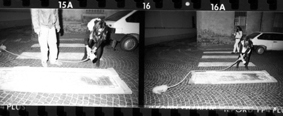
http://www.domusweb.it/it/arte/2007/04/02/la-mappa-del-tesoro.html
domusweb Art 02. Apr. 2007
The treasure map
from Domus 901 March 2007
- With Millemiglia (1997) Patrizia Giambi creates a shift of
- intervention from the natural environment to metropolitan fabric. Her illicit painting of zebra crossings in the city is configured as
- an act of modifying the urban landscape and places in crisis
- bureaucratic circulation and the idea itself of functionality within
- the shared code
- A Sunday morning in October 1969, Robert Smithson, in occasion of his solo show at the L’Attico gallery in Rome, constructed Asphalt Rundown: a flow of asphalt into a shingle quarry. 38 years later, Sue Spaid and Patrizia Giambi went in search of what remains of this forgotten work.
Text by Patrizia Giambi.
the phenomenon for which the
planet’s surface is largely covered by matter that fills its interior,
its inside. The constant passing inside/outside assumes,
gradually, different forms and signs. In practice, cultures change,
but not the elements that go to make it up.
Asphalt, a material with a strong character that today has negative
connotations, is present in large quantities on the ground and
since ancient times has been used for building and fertilizing
as the Assyrians did it for the famous hanging
gardens and the Spaniards in South America; and we also find
it in painting definitely from the 18th century. On January 9, 2005,
with Sue Spaid, I found the exact place that was the setting for
Asphalt Rundown, made by Robert Smithson in 1969 in a
suburb of Rome. The place was a flint quarry.
I would like to point out straight away that flint is an extracted
material used mostly for cladding streets and buildings.
Sue Spaid and I didn’t find the asphalt, obviously it had
disintegrated over the years but on the side
of the quarry on where it was poured we found plants growing
on the same surface and in the same shape of the poured
asphalt as is portrayed in the official photograph, surrounded
by naked earth.
In absence of declarations of the artist, I guess that the work is
presented as something that orders or reorders the fabric of the
ground in the sequence stone-flint-hardness- asphalt-viscosity-
vegetation-air-light and please note that one of the
consequences is that the ground has been fertilized.
Thirty years after that day in 1969, I myself succumbed to the
attraction of asphalt as an organic material.
In 1996 in my exhibition “Burning Colors” at the Lasca Gallery
in Los Angeles I showed 54 teddy bears soaked in
asphalt, with an eye to the strongly sweetened system of values
in American society. But for me it wasn’t enough.
The sense of close collapse that I feel in the western world
has compelled me to look for new passages,
to cross the street, towards Atlantis.
I worked directly on the urban landscape, on the asphalt of the
city. I painted real zebra crossings, but secretly at night,
with other people or groups (Ravenna, Forlì, Bologna, Genova,
Milano, Nice, Amsterdam and Los Angeles).
“(Giambi) uses a convention to obtain a slowing down and a
new passage, effectively useable” wrote Giorgina Bertolino,
“the following morning someone will use the freshly painted
zebra crossing until they are identified as illicit...
The operation (...) is not aimed at an analytical recording of
the so called street behavior but to their alteration provoked
within a code.
The object of such provocation is the idea of functionality itself
and above all in its coinciding exclusively with regulations.
The illicit zebra crossings, those that in other words don’t
belong to the geometry of bureaucratic circulation,
are then semantic traps because they put in crisis the
interpretation of the codified form, causing it to bump
into the function”.
(Zebra Crossing, a.titolo di edizione, Torino, 1998,
pages 45/46)
The formless pouring of asphalt and the geometry of
the zebra crossing fatally vanish, act as a kind of archaeology
of the present, we may hunt for vestiges of Smithson in
the wild environment and one day we may hunt for
vestiges of illicit zebra crossings in urban cities.
Patrizia Giambi